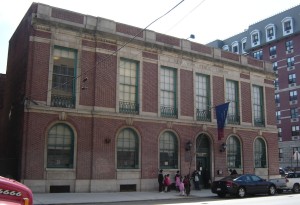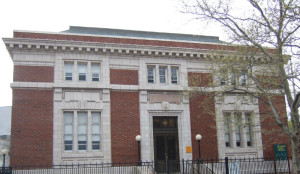CAMPAIGN TO PRESERVE THE CARNEGIE LIBRARIES

Tremont Branch
When steel magnate Andrew Carnegie sought to donate much of his wealth to worthy causes, he made the clear distinction between philanthropy and charity. Carnegie only favored the former and had no interest in helping anyone who would not help themselves. of The construction of public libraries was a perfect focus for his philanthropy for, as Carnegie explained, libraries gave “nothing for nothing. Youths must acquire knowledge themselves.” In total over 2500 libraries throughout the English speaking world were built with his funding, 1600 of them in the United States. The day after he sold his corporation in 1901 to J.P. Morgan for $500 million, Carnegie announced a $5.2 million donation to the construction of public library buildings throughout New York City.
Carnegie’s grant came at the perfect time for New York City and its three separate library corporations, the Brooklyn Public Library, The New York Public Library and The Queens Borough Public Library. Each had been established for less than a decade primarily by combining smaller, free libraries established earlier in the 19th century. The developing professional library field was anxious to revamp these old-fashioned institutions, while the city’s rapidly expanding immigrant and native-born population was a willing audience.
The gift was not a free one though. Going along with Carnegie’s ideal of philanthropy, he helped cities that helped themselves. The grant did not include the $1.6 million New York City would eventually spend for property on which to place the libraries, nor did it cover the cost of books or staffing. Nonetheless, the grant did provide 67 exquisite branch buildings opened between 1902 and 1929.

Bedford Branch front facade
New York City’s neighborhoods clamored to be part of the lucky group of beneficiaries. The New York Public Library’s Secretary George L. Rives summed up the general plan for situating and designing the branches when he wrote in 1901, “The fact that a branch library is constantly before the eyes of the neighboring residents so that all are familiar with its location will undoubtedly tend to increase its usefulness.” The branches were built in central locations, wherever possible near other neighborhood institutions such as schools and YMCAs. With large, shop-like windows looking into their reading rooms and seals and names carved into their facades, the buildings were designed to advertise themselves as libraries. Top architects and their firms including McKim, Mead & White, Carrere & Hastings, Babb, Cook & Willard, Raymond F. Almiral, William Tubby and Lord & Hewlett were hired to design the branches primarily in the popular Beaux Arts style, a favorite of the City Beautiful movement. Their interior plans were designed in cooperation with librarians reflecting progressive library developments with components such as easily accessible stacks, central circulation desks, separate children’s rooms, and large, open reading rooms.

Seward Park Branch, exterior, south façade, c.2007 (HDC)
New York City’s collection of Carnegie libraries is the largest of any city in the country. Of the 67 built, 57 branches are still standing. The 54 that remain in operation make up one quarter of the city’s public library branches. While there have been additions, roof replacements and window changes over the years, most of the libraries still maintain their distinctly “Carnegie” look. 13 branches have been designated New York City individual landmarks (Mott Haven, Park Slope, Aguilar, Chatham Square, Hamilton Grange, Harlem, Muhlenberg, the Schomburg Collection, Tompkins Square, Yorkville, Poppenhusen, Port Richmond and Tottenville) while two are part of city historic districts (Mott Haven and St. Agnes). Two (Hamilton Grange and the Schomburg Collection) are also on the National Register of Historic Places. The entire group are monuments to philanthropy and education, and all deserve protection for their architectural and cultural merits.
Questions should be directed to [email protected] or by calling 212-614-9107.
- Donate to HDC’s Campaign to Save the Carnegie Libraries
- Learn about the Libraries by Borough (scroll to the bottom of the page)
- Carnegie Libraries Booklet (pdf)-Information about the libraries complete with money from Andrew Carnegie.